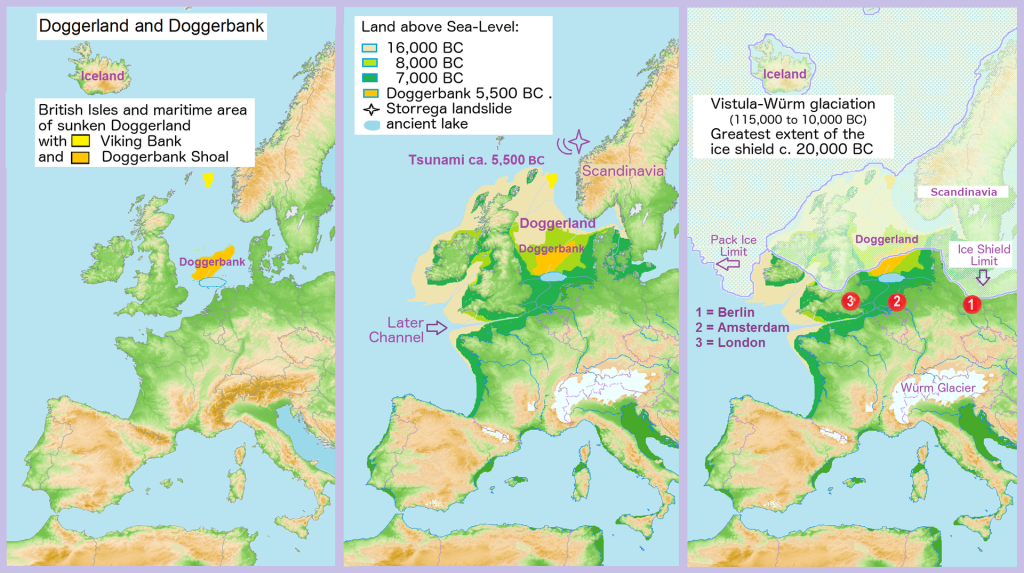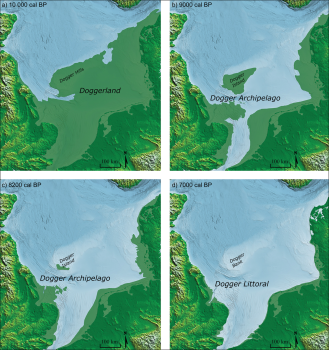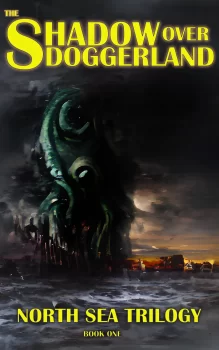Neverwhens: In His Sunken House of… Doggerland… Dead Cthulhu Waits Dreaming
For those not in the know, during the last Ice Age Earth’s seas were about 300 feet lower, revealing a vast amount of land. While no true Atlantis or Mu have been found, examples include a broad plain — and now sunken lakebed — connecting Australia to New Guinea, the Sunda Shelf — a massive sub-continent that unites most of Southeast Asia in a single landmass that includes places as far flung as Java and the Philippines, and Doggerland.
This last was a remnant of an even earlier land mass that had covered the Irish, Baltic and North Seas during the last glaciation, and where we now see the English Channel and the regions of the North Sea that separate the British Isles from Denmark and southern Norway there was land of marshlands and forests, filled with the last remnants of European megafauna such as lions, sabertooths, giant elk, and mammoths. Doggerland was slowly inundated by rising waters, transforming into an archipelago of islands, before being finally subsumed in the late Mesolithic era, likely by a tsunami event.
This lost land provides the setting for The Shadow Over Doggerland, a rather interesting collection of Mythos fiction spear-headed by prolific horror author Tim Medees and published by Nordc Press that asks what actually happened to the people of Doggerland? Was there some great ancient evil bent on destroying the world dreaming below the surface waiting to emerge?
Fifteen authors explore this setting and offer their own look into the story of this doomed land. The collection takes what little we know of the real Doggerland: it survived into the Mesolithic, there were mammoth hunters, there are antler-headdresses and stonework that wash ashore or are pulled up in nets. From there it builds an overarching narrative of mysterious Cthulhu cult allied to the Deep Ones determined to drown the land for a certain octopoidal slumbering god.
 That’s the set-up, and the individual authors are free to riff on this as they will.
That’s the set-up, and the individual authors are free to riff on this as they will.
Certainly this is one of the most original settings for Mythos fiction I can think of, and an interesting way to recast the old trop of the lost civilization. Arguably, the stories are best when the long-established litany of Mythos entities and creatures are downplayed or left unnamed, but there are more than enough call-outs to well-known denizens such as ghouls, Deep Ones, shoggoths, and so forth for those who still thrill to see such things named in print.
The first two thirds of the book create a roughly interwoven narrative that establishes the setting across a sweep of time from the end of the last Ice Age to just before the doomed land’s passing. Well aware of their predecessors in weird fiction placement of lost lands in Europe during and before the last Ice Age, the collection makes efforts to portray Doggerland itself as the last vestiges of those dying worlds.
There’s no real way to perfectly reconcile the works of the “Lovecraft Circle,” and Mendees doesn’t try, rather letting his authors provide their hints and references, leaving us to wonder almost as much as their characters do as they explore the ruins of lost cities. This is most carefully done in Gavin Chappell’s “Crom-Ya and the City of False-Seeming,” a sequel to one of HPL’s own tales — and uses a character he created as an homage to Robert E. Howard, to link the Hyperborea of Clark Ashton Smith with Howard’s Atlantis and Hyboria.
These stories are not sword & sorcery or even dark fantasy, really; they are macabre horror — rarely does the protagonist survive — and the mini-mythos they create is evocative and intriguing, even though not all of the stories are winners. While each of the first five stories are more brilliant than the next, the sixth, “Soldier of Dread,” cowritten by Chris McAuley and Claudia Christian (of Babylon 5 fame) is so stunningly bad it almost undermines everything that came before. Fortunately, it is followed by Gavin Chappell’s “Crom-Ya,” and the dark and evocative “Cave of Many Voices,” by Emil Haskett which looks at the possible underwater source of a young girl’s “cunning” and gift of prophecy. The first arc ends with Mendees own “Holding Back the Flood,” in which Doggerland’s doom is set in motion.
 The last third of the book is entitled “Alternate Histories” — stories I suspect were good enough to make the cut but didn’t really fit the internal mythos series editor Tim Mendes had envisioned.
The last third of the book is entitled “Alternate Histories” — stories I suspect were good enough to make the cut but didn’t really fit the internal mythos series editor Tim Mendes had envisioned.
These are a mixed lot. “Cosmic Macabre” by editor Tim Mendees is a body-horror story of a husband-wife team time-slipped back into Doggerland, that is reminiscent of a kind of 60s short story wherein the 1st person narrators often encounter or a part of all manner of weirdness that the reader is expected to just roll with — as do they — to move things along to the real central focus. It doesn’t really work for me here, but I see what the author wanted to do. “Flesh of My Flesh” by Jasmine Jarvis is an entirely separate/variant mythology for Doggerland, replacing Cthulhu with Tzathoggua, changing the nature of the antler-headed cult, and couching the entire thing in a kind of dark inversion of Gnostic myth that makes the demiurgic Tzathoggua the hero and mankind and mundane life the villain. An interesting, fun story.
Sadly, the collection ends on a problematic note. John D. Chadwick is one of the collection’s most prolific authors, but his tale here, “The Common Time Mysteries,” is almost unreadable. A prose story written with internal rhyme to feel almost like a verse epic poem, the entire thing feels more like a style experiment than a story, and while the concept was intriguing, the execution obscured and slowed the actual story so badly that I not only had trouble following the narrative, I only finished it because it was the final story in the collection. An unfortunate miss on which to end.
Editor-author Tim Mendees is a horror writer from Macclesfield in the North-West of England who specializes in cosmic horror and weird fiction, and who sees his work as the lovechild of H.P. Lovecraft and P.G. Wodehouse. Tim has had over eighty published short stories and novelettes in anthologies and magazines with publishers all over the world. He also has five novellas and a short story collection published via various British small presses. Most (but not all) of the other authors are also British, with only Chadwick and Chapell known to me previously, though also seem fairly prolific.
Despite a few duds, the collection is overall strong and there are some really fresh ideas. This is apparently part of a trilogy of anthologies set in the North Seas region, the next to take place during the Viking Era. I’ll certainly pick it up.
Greg Mele lives in Chicago. His last article for Black Gate was a review of the Blades of Bronze trilogy by Mark Knowles.

This sounds like a fascinating idea– I say that because I’ve had it myself! While the history of land bridges, lost continents and geological upheavals that HPL and REH drew inspiration from did not quite happen like they thought, there were, in fact, land bridges, and lost continents, and geological upheavals that have occurred– many in the time that humans have been on earth.
“interesting collection of Mythos fiction spear-headed by prolific horror author Tim Mendees”
“spear-headed” is certainly the way to describe stories set in the Mesolithic, uh-huh!
And I second the idea of examining land bridges, lost continents, and geological upheavals. My favorite moment in Julian May’s Saga of the Pliocene Exile (The Many Colored Land et al.) was the shattering of the Gibraltar land bridge that caused the Atlantic to come flooding into the dried-up Mediterranean.
An excellent example! I also think that the sudden failure of ice-dams on various glacial lakes and subsequent inundation of the lands would be fascinating (and terrifying).
This is in addition to the various slow-motion apocalypses we’ve inflicted on ourselves over the millennia.
Yes, I loved that element in the Pliocene Exile (a series too forgotten these days, BTW), as well.